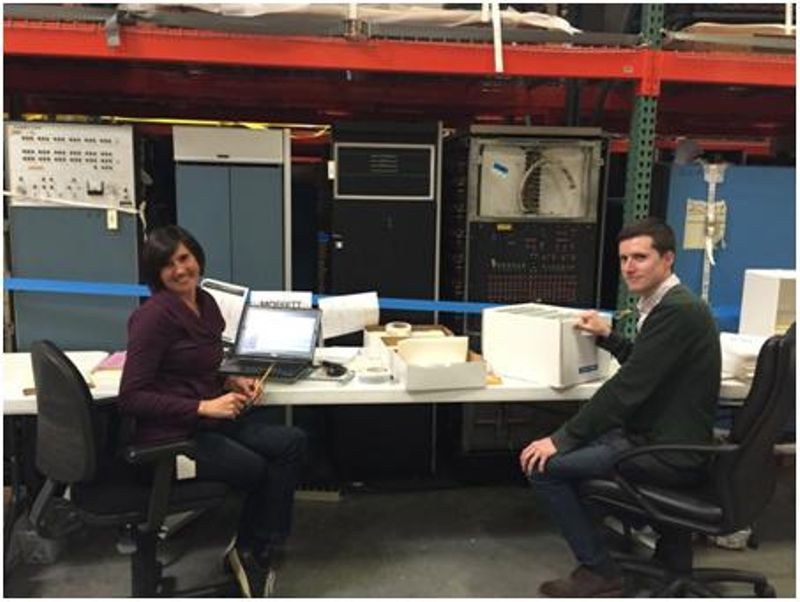
In 2014 the Museum applied for and received a $274,560 grant from the Council on Library and Information Resources (CLIR) to process a portion of its backlog over a span of two years. CHM contributed a cost share of $103,558 in existing staff salaries and supplies, bringing the total project budget to $378,118. We are now six months into CHM’s Archives Processing Project (CHM APP), and we have a lot to report.
The purpose of CHM APP has been to minimally process and make publicly available 26 of the Museum’s most historically valuable yet unknown collections, totaling 1,944 linear feet of material, or roughly 1,500 bankers boxes (a linear foot is the same as a foot, 12 inches. The difference is that it specifically refers to space on a shelf). Collections in the project include the Community Memory Records, Dennis Austin PowerPoint Records, Jim Porter Papers, and the Digital Equipment Corporation Records among others.
When CHM decided to propose a minimal processing project, we knew that we would be making a tradeoff between description and access. When processing speed is increased from one linear foot per 12 hours to one linear foot per 4 hours, you triple your rate of processing, necessarily losing detail but increasing the speed at which you open up collections. In two years the Museum could either traditionally process 364 linear feet of material (approximately 290 boxes), or we could put the pedal to the metal, lose quite a bit of description, and open nearly 2,000 linear feet of material to scholars. We decided to go the route of speed and access.
The choice to minimally process collections was really one of necessity. Prior to beginning this project, CHM had a backlog of approximately 4,500 linear feet of material. We have an obligation to our donors to make headway on this backlog, as well as an ethical imperative to expose our collections. But the limitations of staff, time, and money make traditional processing an ineffective approach. It would take one archivist 20 years to process the entire backlog, and that does not take yearly growth into account.
MPLP (More Product, Less Process), as minimal processing has been known since Mark Green and Dennis Meissner introduced the approach in 2005, has become a generally accepted method. It’s taught in library schools, it’s a popular paper topic at conferences, and it’s a common area of questioning in job interviews.
This two-year project has been CHM’s first real attempt to integrate MPLP into its processing, and so far it’s working for us. To date, the project’s archivists and volunteers have been able to maintain an average processing rate of just over 4 hours per linear foot. And even better, the collections are being used! To date, CHM APP has opened 15 collections totaling 314 linear feet of material to researchers.

CHM APP Assistant Archivist Kim Hayden (left) and Project Archivist Bo Doub (right) pause from processing the Jim Porter Papers at the Museum’s offsite storage facility.
Of the seven collections that have had their finding aids published so far, CHM has had researchers visit the archive specifically to conduct research in four of them. That’s over half the publicized collections attracting researchers in the first six months. Remarkable! And beyond my wildest expectations. Without the funds provided by CLIR to process and publicize these collections, those researchers would have had no way of knowing these collections existed. This project has proven to me what I have always felt to be true. Researchers prefer having access to a high number of minimally processed collections, over access to a few intensively described collections, despite the onus this style of processing puts on them to do more detective work.
A giant thank you to the Council on Library and Information Resources for providing the funds that have made this project possible through their Cataloging Hidden Special Collections and Archives Grant. As CLIR states, “libraries, archives and cultural institutions hold millions of items that have never been adequately described... [and] are all but unknown to, and unused by, the scholars those organizations aim to serve.” Over the next one and a half years we will be opening up additional and larger collections, including the much anticipated Digital Equipment Corporation Records, revealing more of the innumerable treasures held by CHM. We can hardly wait to learn what discoveries will be made by researchers who finally have access to these materials.
CHM’s Archives Processing Project (CHM APP) is modeled after the CLIR-funded Philadelphia Area Consortium of Special Collections Libraries’ Hidden Collections Processing Project undertaken in 2009–2011.